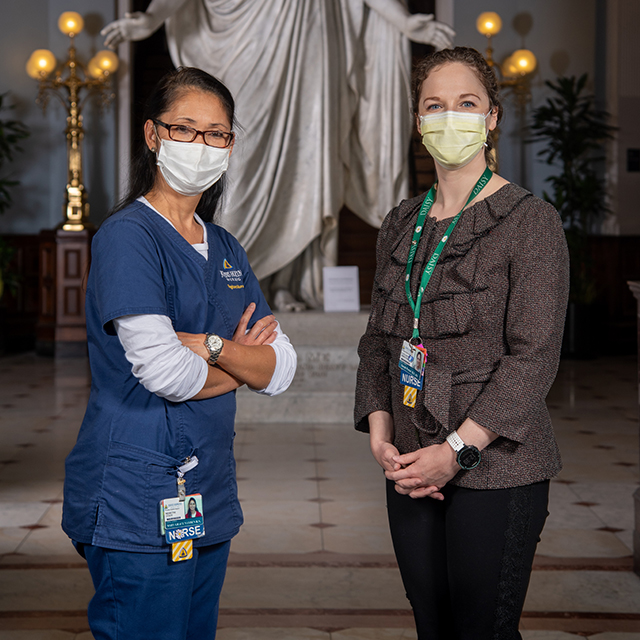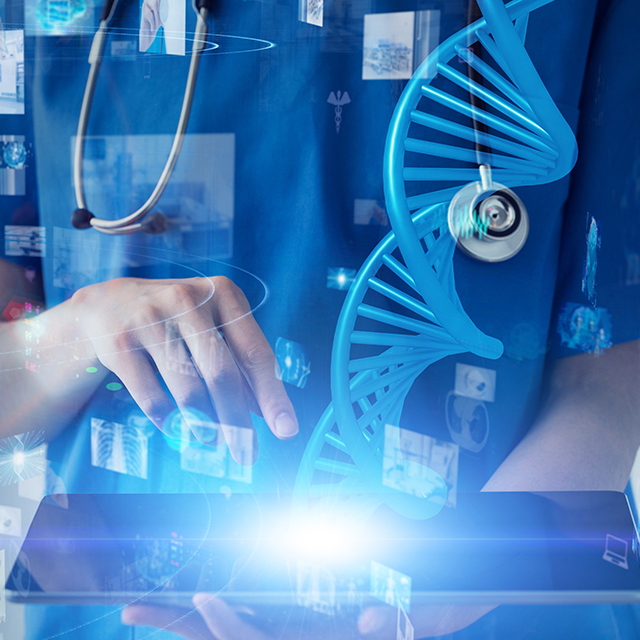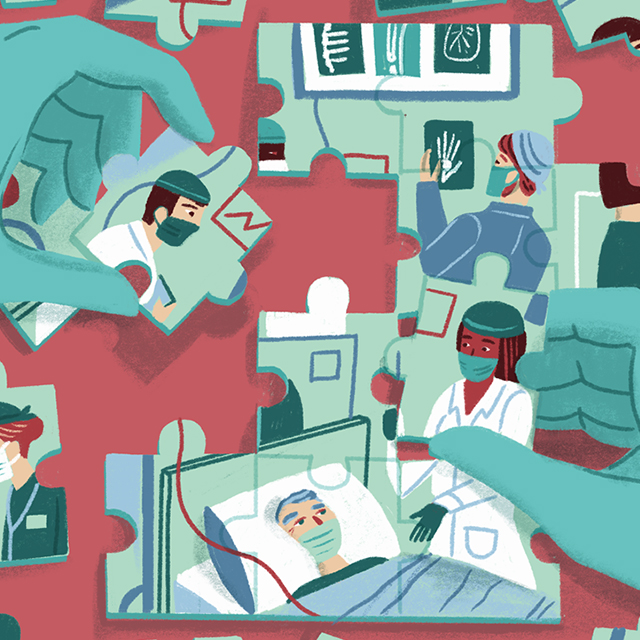When the COVID-19 pandemic intensified an already competitive market for experienced nurses, hospitals across the country, including Suburban Hospital, hired large cohorts of newer nurses to fill vacant positions.
Once those nurses completed their orientation period, they were often rotated to the night shift. While day shifts typically have supervisors and educators providing mentorship to newer nurses, the reduction in staff typical of any hospital during the night shift means there are fewer people around to help newer nurses as they refine their clinical skills, including how to troubleshoot medication issues and interpret vital signs.
Suburban’s answer to this challenge was to create a new post: the nursing professional development specialist (NPDS) for the night shift. The idea, says Karin Nevius, director of professional practice and nursing quality, was for an experienced nurse to be a hands-on resource for new graduate nurses and nurses with one to two years of experience on the night shift. The position started as a six-month pilot, but proved to be so helpful that it’s now permanent.
“The value of being able to think on your feet and recognize subtle changes in a patient’s condition, and knowing what could be contributing to them, is huge in nursing,” Nevius says. “But there’s not a course for it. What this position does is give these nurses someone to talk to and help figure it out. Offering this level of support at night is a concept not often seen in hospital settings.”
Elizabeth Gabriel, the nurse who has worked as the night shift NPDS since December 2021, has gone above and beyond, Nevius says. Working with 12 different nursing units at Suburban, Gabriel has become a go-to resource for helping new nurses learn skills and troubleshoot clinical conundrums during the night shift.
At the bedside and in workshops, Gabriel teaches nursing skills including placing feeding tubes, starting intravenous lines, managing central lines (tubes placed in large veins to deliver fluid, blood and medications), inserting catheters, managing medications and performing dialysis.
“I like stepping in, in real time, and helping people figure out the best course of action for a particular patient,” Gabriel says. “I think that’s how people learn really well. I know it’s how I learned.”
For example, when one patient’s blood pressure was low, Gabriel walked a nurse through causes and treatment. First, “user errors” were ruled out — the blood pressure cuff being too large or the automatic machine not accurately measuring low blood pressure. She spoke to the nurse about what to do when blood pressure is low and how treatment can vary based on the cause. Then she helped the nurse give an infusion of albumin, a protein that causes fluid to move into the blood vessels, thus increasing blood pressure, before rechecking the patient’s levels.
During the night shift, Gabriel also helps with hospital-wide initiatives such as fall prevention and reducing hospital-acquired infections. Before Gabriel worked in this role, night nurses would have to find time during daytime hours to work with a nurse educator or attend a group education class, or day shift educators would have to work with these nurses during the night shift.
A Family Legacy of Problem-Solving
Gabriel says she’s a natural problem-solver who has always liked teaching because it runs in her family: Her mother, Patricia Gabriel, is the NPDS at Suburban for the emergency department, the clinical decision unit (CDU), and the trauma and pediatrics units.
During her 10 years as a nurse, Elizabeth Gabriel has been a staff nurse and charge nurse in the CDU, an area of the hospital where patients who don’t need to be admitted but are not well enough to go home can be monitored for periods generally less than 24 hours. Before her current role, she was an oncology nurse working nights.
Gabriel was finishing her master’s degree in nursing education, with Nevius as her preceptor, when the NPDS position opened up.
“She knows the nuances of the night shift, the challenges that come about being on nights, what the resources are and how to get the best patient outcomes in the middle of the night,” Nevius says.
With her role now permanently incorporated into Suburban’s NPDS team, Gabriel looks forward to further enhancing night shift educational offerings.
“It’s a really challenging but rewarding time to be a nurse. Due to the pandemic, we’re seeing fallout of people who haven’t gone to a doctor in two years, and there are a lot of new nurses who didn’t get to have a ton of clinical time as students,” Gabriel says. “The value of being able to sit with, debrief and mentor these nurses is my favorite part of doing this.”




